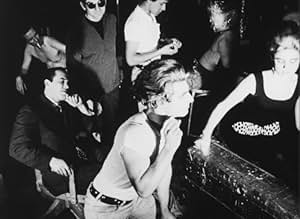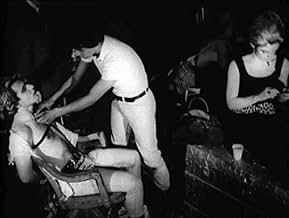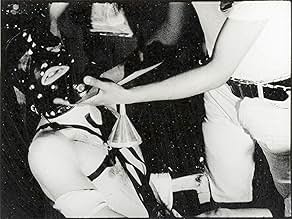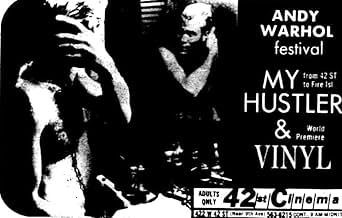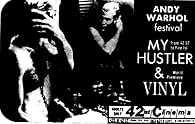Vinyl
- 1965
- 1 h 10 min
AVALIAÇÃO DA IMDb
4,2/10
1,2 mil
SUA AVALIAÇÃO
Adicionar um enredo no seu idiomaWarhol's strange interpretation of "A Clockwork Orange." Includes Gerard dancing to the Martha and the Vandellas classic "Nowhere to Run" and being tortured by professional sadists.Warhol's strange interpretation of "A Clockwork Orange." Includes Gerard dancing to the Martha and the Vandellas classic "Nowhere to Run" and being tortured by professional sadists.Warhol's strange interpretation of "A Clockwork Orange." Includes Gerard dancing to the Martha and the Vandellas classic "Nowhere to Run" and being tortured by professional sadists.
- Direção
- Roteiristas
- Artistas
- Direção
- Roteiristas
- Elenco e equipe completos
- Produção, bilheteria e muito mais no IMDbPro
Avaliações em destaque
Andy Warhol very very loosely adapts "A Clockwork Orange". Gerard Malanga tells us all how much of a juvenile delinquent he is and then furious dances to Martha and the Vandellas while Edie Sedgwick watches. Then Ondine, playing his buddy Scum Baby, turns him in to a cop who has been sitting in a chair and laughing the whole time. The cop turns him over to a doctor who tortures him, which seems to be a real S&M kinda deal ... no faking. Malanga is reformed. All of this happens on one set with the whole cast present the whole time. At just over an hour long, it's way too long ... but the peak moments, like Malanga's dance or any randomly selected minute of Sedgwick sitting on the sideline, make the whole thing worth watching.
The first film version of Anthony Burgess' classic 1962 novel A Clockwork Orange is not Stanley Kubrick's celebrated 1971 film of the same name, but a 70-minute art film by no less a person than Andy Warhol. Andy may have had talent in his pop art, but his direction in Vinyl leaves something to be desired.
I just read Burgess' novel for the first time this weekend, and unless people in 1965 had read it first, they might have had considerable difficulty trying to decipher just what in God's name is going on on-screen. The camera stays in one place for the whole movie, which adds to the feeling you're watching a high school play. Indeed, our protagonist reads out his lines with the monotony and lack of emotion you'd expect from high school actors. The film includes a couple things from the book not in Kubrick's version- the protagonist tearing up the books of a victim, a speech about how no one asks why a good person does good things. But in removing the Nadsat, Warhol in effect guts the story of its poetry.
The dancing to music goes on too long, and the protagonist describing what he sees in the conditioning films gets repetitive fast. Although I'll admit, I laughed good when they finally mixed it up with something truly bizarre- "I see little children having their teeth pulled out by yellow dwarfs." Wait, what? At the end of the day, it's Kubrick's version that does the most justice to its source material, and that's the reason it's the most remembered version.
I just read Burgess' novel for the first time this weekend, and unless people in 1965 had read it first, they might have had considerable difficulty trying to decipher just what in God's name is going on on-screen. The camera stays in one place for the whole movie, which adds to the feeling you're watching a high school play. Indeed, our protagonist reads out his lines with the monotony and lack of emotion you'd expect from high school actors. The film includes a couple things from the book not in Kubrick's version- the protagonist tearing up the books of a victim, a speech about how no one asks why a good person does good things. But in removing the Nadsat, Warhol in effect guts the story of its poetry.
The dancing to music goes on too long, and the protagonist describing what he sees in the conditioning films gets repetitive fast. Although I'll admit, I laughed good when they finally mixed it up with something truly bizarre- "I see little children having their teeth pulled out by yellow dwarfs." Wait, what? At the end of the day, it's Kubrick's version that does the most justice to its source material, and that's the reason it's the most remembered version.
This footage is little more than a filmed rehearsal in a corner of a warehouse. Warhol demonstrates the 'less is more' mantra to an unplumbed basement of embarrassment. This vision of Warhol's really has nothing to do with the medium of film, and all that is learned is that he was very spoiled to have the resources in order to make this, for there are bound to be more important artists and concepts (and even adaptations) that went un-filmed in this era of early experimentation.
Warhol fills a stage with the cast, and we can only sympathize with them, for their talents are criminally obstructed by the moronic limitations imposed upon them. With presumably only the source text (a novel) to go by (for who would argue that any useful screenplay was written?), the actors go about filling out the bare guidelines of the inappropriately treated material. Warhol, like a spoiled child, asks so much of his cast while giving so little; and beyond that, he almost seems to obstruct or minimize the source material.
Given this, the performers do what they can when they can, and without them, this film would have nothing to give. Warhol's demonstrated contempt for cinema acts as a saboteur; the performers at the mercy of his nonconstructive (mark it, not 'de-constructive') approach, and we are forced to watch them feel for cues, lines and staging directions. Shamefully, it is left for them to stick their necks out. Warhol, like a selfish undergraduate, seems to hide childishly behind the camera – the very last place any true artist would escape to.
Carillo, Latrae and particularly Malanga are victorious even with these enormous obstructions (not, I argue, because of them). Their lines are delivered fairly robotic-like and sporadically; a rhythm is established because of this, but it abandoned well into the 'second-reel'. Here we are treated to some off-camera sadism, while even the most hardened of extras (E. Sedgewick for example) remain distant, unmoved and as bored as anyone else involved: actors and audience alike. When the cast display indifference and the director promotes his carelessness, we are only left with spectacle. Even there, 'Vinyl' has little to give. The highlight of the film (or at least the most memorable set piece) is that of Malanga dancing to 'Nowhere to Run'.
Twice.
Following this there is a smattering of whipping, strapping, beating and struggling. The film then descends into further unscripted stumbling and ramblings. Most of it stays in frame.
I can't see what Warhol gave us with this film. The narrative is lost, the actors are maltreated, and the production values do more harm than good. Warhol fails on virtually all grounds here – the real kudos needs to go to the performers. This film is a very selfish one, spawned from a selfish, lazy director.
Warhol fills a stage with the cast, and we can only sympathize with them, for their talents are criminally obstructed by the moronic limitations imposed upon them. With presumably only the source text (a novel) to go by (for who would argue that any useful screenplay was written?), the actors go about filling out the bare guidelines of the inappropriately treated material. Warhol, like a spoiled child, asks so much of his cast while giving so little; and beyond that, he almost seems to obstruct or minimize the source material.
Given this, the performers do what they can when they can, and without them, this film would have nothing to give. Warhol's demonstrated contempt for cinema acts as a saboteur; the performers at the mercy of his nonconstructive (mark it, not 'de-constructive') approach, and we are forced to watch them feel for cues, lines and staging directions. Shamefully, it is left for them to stick their necks out. Warhol, like a selfish undergraduate, seems to hide childishly behind the camera – the very last place any true artist would escape to.
Carillo, Latrae and particularly Malanga are victorious even with these enormous obstructions (not, I argue, because of them). Their lines are delivered fairly robotic-like and sporadically; a rhythm is established because of this, but it abandoned well into the 'second-reel'. Here we are treated to some off-camera sadism, while even the most hardened of extras (E. Sedgewick for example) remain distant, unmoved and as bored as anyone else involved: actors and audience alike. When the cast display indifference and the director promotes his carelessness, we are only left with spectacle. Even there, 'Vinyl' has little to give. The highlight of the film (or at least the most memorable set piece) is that of Malanga dancing to 'Nowhere to Run'.
Twice.
Following this there is a smattering of whipping, strapping, beating and struggling. The film then descends into further unscripted stumbling and ramblings. Most of it stays in frame.
I can't see what Warhol gave us with this film. The narrative is lost, the actors are maltreated, and the production values do more harm than good. Warhol fails on virtually all grounds here – the real kudos needs to go to the performers. This film is a very selfish one, spawned from a selfish, lazy director.
Man, that Andy Warhol must have really not wanted to spend any money on his movies. I can't even really call this a movie, since it follows no story, and no real directing and acting.
Watching this was an horrible experience and it actually felt like a torment. What this movie basically is are Andy Warhol's usual groupies sitting in a corner with a camera pointed at them, doing either weird stuff or absolutely nothing. Appearantly this was Andy Warhol's version and interpretation of Anthony Burgess' 'A Clockwork Orange' but the movie doesn't even follow its story. It's as if Warhol one day picked up a camera and said 'let's shoot something, I'm bored!'. I'm sure they all had good fun doing weird stuff in front of the camera but why bother us with it? The movie doesn't make a point about anything. It doesn't provoke and it's not even artistically a well shot movie.
The camera doesn't move at all, not even when the actors accidentally are out of frame. Also no cuts were made and I'm pretty sure they never rehearsed or prearranged anything. Everything was shot on the spot and things were made up as it moved along. As a result of this the movie just goes on and on, even when absolutely nothing is happening. I seriously had to fast-forward through most of this movie or else I would had most likely never been able to finish it. It was that pointless, annoying and just plain awful to watch.
Funny thing is that the 'actors' themselves also didn't had a clue what they were doing. You can constantly hear voices off cam whispering their lines and saying what they should do next. Besides, they are simply horrible at what they are doing. Edie Sedgwick constantly had a hard time not laughing or looking at the people behind the camera's. Highly annoying and distracting.
Completely unwatchable, even from an artistic viewpoint.
1/10
http://bobafett1138.blogspot.com/
Watching this was an horrible experience and it actually felt like a torment. What this movie basically is are Andy Warhol's usual groupies sitting in a corner with a camera pointed at them, doing either weird stuff or absolutely nothing. Appearantly this was Andy Warhol's version and interpretation of Anthony Burgess' 'A Clockwork Orange' but the movie doesn't even follow its story. It's as if Warhol one day picked up a camera and said 'let's shoot something, I'm bored!'. I'm sure they all had good fun doing weird stuff in front of the camera but why bother us with it? The movie doesn't make a point about anything. It doesn't provoke and it's not even artistically a well shot movie.
The camera doesn't move at all, not even when the actors accidentally are out of frame. Also no cuts were made and I'm pretty sure they never rehearsed or prearranged anything. Everything was shot on the spot and things were made up as it moved along. As a result of this the movie just goes on and on, even when absolutely nothing is happening. I seriously had to fast-forward through most of this movie or else I would had most likely never been able to finish it. It was that pointless, annoying and just plain awful to watch.
Funny thing is that the 'actors' themselves also didn't had a clue what they were doing. You can constantly hear voices off cam whispering their lines and saying what they should do next. Besides, they are simply horrible at what they are doing. Edie Sedgwick constantly had a hard time not laughing or looking at the people behind the camera's. Highly annoying and distracting.
Completely unwatchable, even from an artistic viewpoint.
1/10
http://bobafett1138.blogspot.com/
There are bad movies, and there are BAD movies. After 70 agonizing minutes, I realized this is genuinely in the running for worst movie I've ever seen. I can't think of a single redeeming feature, just the bad ones, from the wooden acting, truly unimpressive cinematography and staging, (I'd complain about the editing, but there is none), etc.
Best to just read the book and watch the Kubrick movie.
Você sabia?
- CuriosidadesIncluded among the "1001 Movies You Must See Before You Die", edited by Steven Schneider.
- ConexõesFeatured in Exploding Plastic Inevitable (1967)
- Trilhas sonorasNowhere to Run
Written by Lamont Dozier, Brian Holland and Eddie Holland
Performed by Martha & The Vandellas
Principais escolhas
Faça login para avaliar e ver a lista de recomendações personalizadas
- How long is Vinyl?Fornecido pela Alexa
Detalhes
- Tempo de duração1 hora 10 minutos
- Cor
- Mixagem de som
Contribua para esta página
Sugerir uma alteração ou adicionar conteúdo ausente



